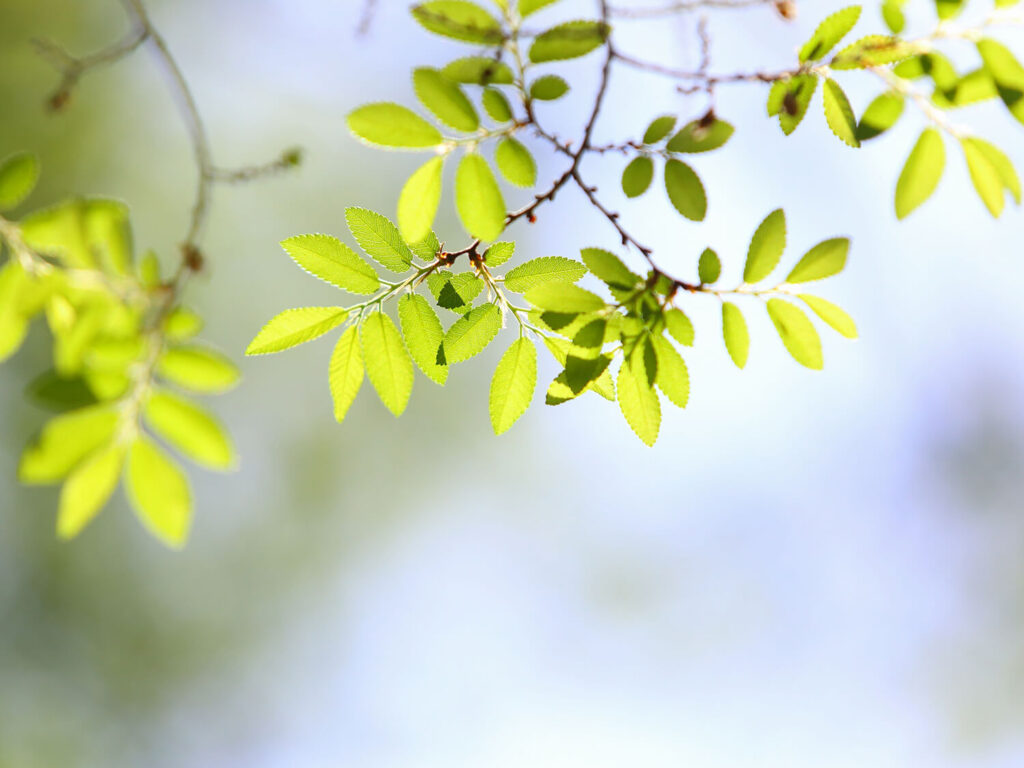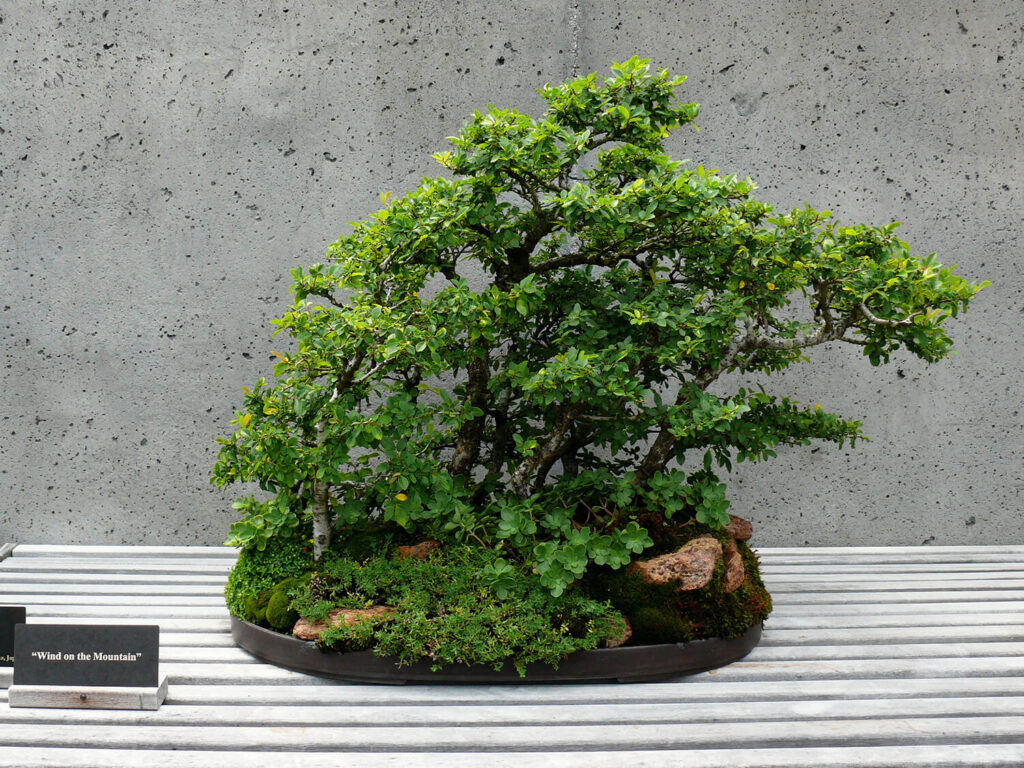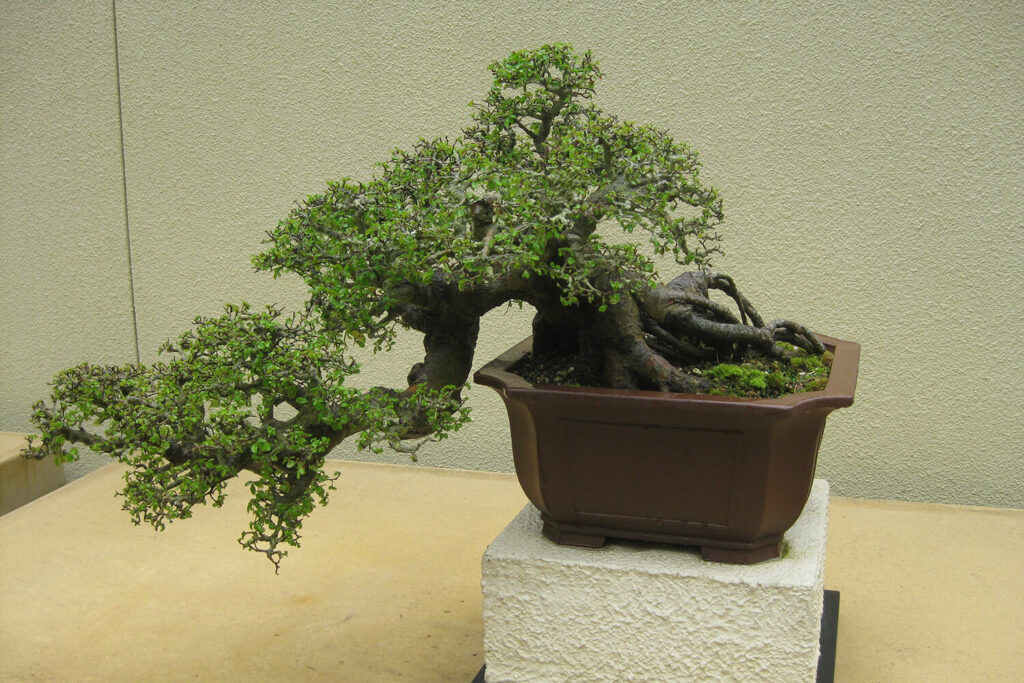Growing a Chinese elm bonsai is perfect for beginners since it’s extremely robust and can tolerate various climate conditions—making it a good practice specimen for more advanced tree species.
If you want to know how to properly and successfully cultivate one…
Read on to discover:
- Description and growth habits of Chinese elm species.
- How to cultivate a Chinese elm miniature tree indoors and outdoors.
- Several ways to propagate a Chinese elm for bonsai growing.
- And so much more…
General Information about Chinese Elm Trees
| Botanical name: | Ulmus parvifolia |
| Family: | Ulmaceae (elm) |
| Tree type: | Broadleaf deciduous tree |
| Foliage type: | Simple with toothed edges and alternating leaf pattern |
| Growth habit: | Upright |
| Native habitat: | East Asia (mostly China, Japan, and Korea) |
| Distinctive feature: | Gray bark and small, shiny leaves |
Chinese elms are upright deciduous trees native to East Asia that can grow up to 80 ft. (25 cm). Like most elms, Chinese elm trees turn their small leaves yellow or brown in the fall before they drop in the winter—revealing stunning fine branch ramifications.

Natural green leaves of Chinese elm trees.
Yellow-brown leaves of Chinese elms during autumn months.

They’re popular for their beautiful gray bark that flakes off with age, revealing orange-brown colors, and their small leaves, which is a very suitable feature for bonsai art.
Chinese Elms for Bonsai Cultivation
Many elm trees can be used for bonsai cultivation, but Chinese elm is the most popular for its best suitable features. Additionally, it’s widely available in shops worldwide at an affordable cost.
If you want to cultivate Chinese elm miniature trees, here are some ways you can propagate them:
- Cuttings: best to be done in late spring
- Planting seeds: stratify in winter, sow in spring
- Root cutting: best done in late spring using thick roots
Many bonsai artists get the best and faster results when propagating cuttings rather than planting seeds. However, if you want to perform actual bonsai cultivation techniques much earlier, buying a pre-bonsai specimen or a young tree is better.
How to Care for a Chinese Elm Bonsai
Growing a Chinese elm as a very small bonsai requires not only dedication and passion but also proper knowledge and skills.
To help you successfully grow one, here’s an easy-to-follow guide you can follow:
Quick general care guide for Chinese elm miniature tree:
- Positioning: Thrives outdoors but can be kept indoors.
- Watering: Water regularly—once the soil becomes slightly dry.
- Feeding: Fertilize only during the growing season.
- Pruning: Prune the shoots back to 1-2 leaves in the spring or summer.
- Wiring: Can be done anytime, but best in the winter for convenience.
- Repotting: Repot every 2 to 5 years in the early spring.
- Overwintering: Can be kept in a cool, frost-free location outdoors.
I. Positioning
Although Chinese elm miniature trees thrive outdoors, you can also keep them as indoor bonsai.
If kept outdoors, place it in an open-air spot that receives full sun year-round. However, when the temperature is too high in mid-summer, move it in partial shade to prevent leaf burn.
If kept indoors, position it in a bright location with good air movement to encourage healthy, thriving growth—preferably in a south-facing window.
II. Watering
Although Chinese elm miniature trees are extremely robust, they can’t endure constant moisture and prolonged drought (too wet and too dry soil).
With that in mind, never water on routine but on observation. Water your bonsai tree only when needed—once the topsoil dries slightly. You may also use a moisture meter to monitor the soil’s moisture level.
When watering, ensure that the entire root mass is soaked. Pour water into the soil until the water runs out in the drainage holes. Then, do it again after a few minutes to fully wet the bonsai soil.
Tip: If kept indoors, water your Chinese elm miniature tree in the sink or outdoors, and use a drip tray to avoid mess.
Watering Chinese elms based on the season
The watering needs of Chinese elm miniature trees change as the season shifts.
Here’s how you should water your bonsai depending on the season:
A. In spring
Trees start to grow rapidly in the spring. Hence, their need for water increases.
During this season, check your bonsai at least twice daily and water once the soil dries up slightly.
B. In summer
As the temperature rises and your bonsai receives more sunlight, the faster its soil dries up—increasing the risk of underwatering.
That said, check your tree twice or more a day and water it generously. You may also mist your tree daily to ensure more moisture.
C. In autumn
The tree’s growth slows during this season as it prepares for dormancy. Therefore, the tree’s water intake gradually decreases.
Check your bonsai at least once a day for watering.
D. In winter
Chinese elm specimens become dormant in the winter seasons.
During this time, decrease your water frequency to a few times a week.
III. Fertilizing
Chinese elm is a fast-growing species, but fertilizing it during the growing season can help further boost its growth and health. Do it from spring to summer (roughly March to August) to encourage the great development of new shoots.
For balanced fertilization, use slow-release pellet fertilizers. Depending on the product, you may need to apply fertilizers every few weeks or more.
Feeding Chinese elm based on their needs
Adjust your feeding frequency depending on your bonsai tree’s health and growth stage.
To help you out, here’s how you should fertilize your Chinese elm bonsai tree based on its condition:
A. For health enhancement
Younger trees need more health support. Hence, you should apply more fertilizers on such specimens to promote faster and thriving growth. You may also perform foliar feeding using a liquid concentrate for extra nourishment.
B. For general development and refinement
On the other hand, mature and older trees need less fertilizing since their growth is already established. Decrease your feeding frequency and choose a fertilizer with less intense components.
IV. Pruning

Regular pruning is necessary to maintain the shape and control the growth of your Chinese elm miniature tree. Doing it is also essential to promote fine branch ramifications.
Once the shoots grow 3 or 4 nodes, prune them back to 1 to 2 leaves.
Cutting branches
You can safely remove larger branches on a Chinese elm specimen since it tolerates strong pruning and grows buds from old wood.
The best time to do it is in late autumn when the tree finally becomes dormant.
If you want more information on how to prune a Chinese elm bonsai, watch this tutorial video:
V. Wiring and Bending

You can wire your Chinese elm miniature tree any time of the year. Some bonsai growers do it in the spring after pruning the leaves.
However, for convenience, wire your bonsai in early or mid-winter once the leaves drop. Doing this helps you access the inner branches more easily—allowing you to style your bonsai to your desired shape more freely.
For Chinese elm miniature tree species, use an aluminum alloy bonsai wire and wrap it tightly to your tree at a 45 to 50 degrees angle for best support. When wiring larger branches, use guy wires for stronger and more stable support, helping achieve your desired position.
Note: Remove the bonsai wire in the spring once it starts to bite into the bark.
VI. Repotting
Repotting your Chinese elm miniature tree is necessary to keep them healthy in a small, shallow bonsai pot.
Depending on the age of your bonsai tree, here’s how often you should repot it:
- Young specimens: every 2 years
- Old, mature species: 3 to 5 years
Note: The above digits are just estimates. You should repot your bonsai tree when needed—once the roots start circling the pot.
To prevent damage, repot your Chinese elm miniature tree in the early spring before the new shoots swell.
Root pruning
Since their roots grow strong and fast, you should also perform root pruning during repotting to control the tree’s growth and encourage the development of smaller new roots. Make sure to cut them with precision to create a good nebari.
Don’t prune more than a quarter of the root mass, as this can harm your plant’s health.
Soil requirement
Chinese elm plants don’t have special soil requirements.
When repotting, use a fresh set of well-draining bonsai soil. Since this tree species doesn’t like too wet or too dry soil, choose a mix of substrates that are coarse, porous, and have water-retaining properties.
VII. Winter Care
Since Chinese elm miniature tree species are frost-hardy, they can be left outdoors during the winter months in temperate climates. It can tolerate a very low freezing temperature of up to 23°F (-5°C).
Note: Some varieties can tolerate much less frost. When buying one, make sure to identify the background and native habitat of the plant so that you can provide the proper care.
Usually, the specimens from the northern regions of China are more frost-hardy than their southern region counterparts.
If kept indoors, move it to a cool/cold but bright area during the winter.
“Why didn’t the leaves of my Chinese elm drop in winter?”
Depending on winter temperatures, your Chinese elm miniature plant may drop its leaves in the winter or keep its leaves until new buds appear in the spring.
The latter usually happens when the tree doesn’t enter dormancy due to high temperatures. When it’s too warm, the tree can fail to form abscission cells which prompt the tree to drop its leaves during dormant seasons.
If you want to showcase your Chinese elm’s fine branches in the winter, provide the proper conditions so the tree can enter dormancy successfully. You can do that for indoor bonsai by gradually moving your Chinese elm miniature tree to a cool/cold area starting in late fall.
VIII. Pests and Diseases
If not cared for properly, Chinese elm miniature tree species can be infested by scales and spider mites. These pests usually occur when humidity is low.
Suppose your tree suffers from any of the mentioned pests. Here’s what you can do:
Treatment
Get a pesticide formulated specifically for spider mites and scales, and apply it to your tree following the product’s instructions.
Do it early morning or evening when the wind speed is low, as you don’t want the pesticide to affect the other healthy plants. Also, avoid applying pesticides when it’s raining, as it’ll only wash off the treatments.
Prevention
Increase the air humidity in the area by doing the following:
- Mist the leaves when the temperature is high.
- Move the bonsai to an open-air location, away from tall shrubs, hedges, and trees.
- Keep the bonsai away from concrete walls and pavements. If not possible, wet the surrounding areas when the temperature is high.
Most importantly, improve the condition of your bonsai by providing it with proper care and regular maintenance.
Conclusion
All Chinese elm miniature trees require regular care to grow and thrive for many years. Luckily, this species is easy to care for, so beginners can use this as their first practice specimen.
Unlike other deciduous species, Chinese elm bonsai can be kept indoors or outdoors—making it a great display in any home. It also changes leaf colors in autumn and drops leaves in winter, showcasing several different aesthetics throughout the year.
Check out www.hookedonbonsai.com to discover other suitable tree species to cultivate for bonsai.





0 Comments